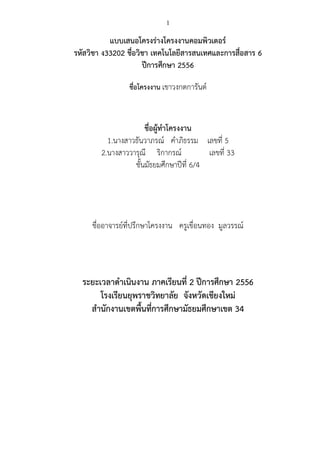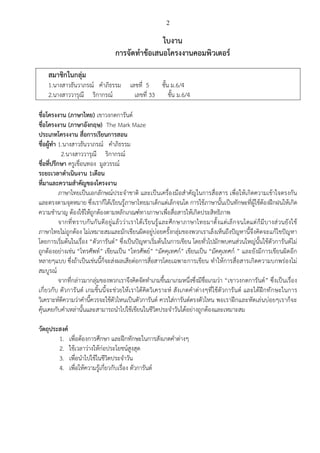??????????
- 1. 1 ????????????????????????????????? ???????? ?33202 ???????? ?????????????????????????????? 6 ?????????? 2556 ??????????? ?????????????? ????????????????? 1.??????????????? ????????? ?????? 5 2.???????????? ???????? ?????? 33 ??????????????????? 6/4 ??????????????????????????? ???????????? ???????? ?????????????????? ??????????? 2 ?????????? 2556 ?????????????????????? ???????????????? ???????????????????????????????????????? 34
- 2. 2 ????? ?????????????????????????????????? ????????????? 1.??????????????? ????????? 2.???????????? ???????? ?????? 5 ???? ?.6/4 ?????? 33 ???? ?.6/4 ??????????? (???????) ?????????????? ??????????? (??????????) The Mark Maze ????????????? ?????????????????? ?????????? 1.??????????????? ????????? 2.???????????? ???????? ????????????? ???????????? ???????? ?????????????????? 1????? ???????????????????????????? ?????????????????????????????? ??????????????????????????????????? ???????????????????????????? ???????????????? ???????????????????????????????????????????? ???????????????????????????????????????????????? ?????????? ?????????????????????????????????????????????????????????????????? ??????? ????????? ?????????? ?????????? ??????? ?????? ?????????????? ? ???? ??? ??????? ????? ???? ????? ??? ????????????????? ???????????????????????????????????????????????????????????????????????????????????????? ?????????????????????? Ī░??????????Ī▒ ??????????????????????????????? ???????????????????????????????????????????? ???????????????? Ī░????????Ī▒ ????????? Ī░????????Ī▒ Ī░??????????Ī▒ ????????? Ī░?????????? Ī▒ ?????????????????????? ???????? ???????????????????????????????????????????????????????????? ?????????????????????????????????? ??????? ???????????????????????????????????????????????????????????????????????? Ī░??????????????Ī▒ ?????????????? ????????? ?????????? ???????????????????? ????????????????? ??? ??????????????????????????? ????????? ??? ??????? ???????????????????????????????????????????????????? ?????????????????????? ?????????????????????????????? ????????????????????????????????????????????????????????????????????????????????????? ???????????? 1. ????????????????? ?????????????????????????????? 2. ??????????????????????????????? 3. ????????????????????????????? 4. ?????????????????????????????? ??????????
- 3. 3 ????????????? 1.???????????????????????????????????????????????????????? 2.??????????????????????????????????????? 2 ????? 3.????????????????????????????????????? 3.1 ?????? 3.2 ???????? ?????? ????????? ????? 3.3 ?????????? 3.4 ?????????? 3.5 ???????? 3.6 ???????? 3.7 ???????? 3.8 ???????????? ??????????????? (??????? ??????? ?????????????????????????????????) ?????????? ??????? ( ? ) ??????? ( ???+?????) ?????? ????????????? ?????????????? ????????????????????????????? ????????????????? ? ??????? ????????? ??????? ?????? ????????????? ?????????????????????????????? ?????????????????????? ???????????? ??????????? 1. ????????? ????????????????? ??????????????????? ???? ???? ???? ??? ??? (????) ?????=???????, ?????? 2. ??????????????????? (????????) ??????????????????? ???? ???????? = ???? (????, ????), ????????? = ?? ????? ???????? (????, ???) 3. ?????????????????????? ?????????????? ???????????? ?) ???????????????????????????? ????????????????? ???????????????????????????????? ????????????????????????????? ???? ????? ?????? ??????? ??????? ????? ??????????? ????? ????? ???? ???? ????? ???????? ??????? ????????? ?) ??? ? ???????????????????????????? ?????????????????????? ???? ???? ???? ???????? ???????? 4. ?????????????????????????? ????????????????????????? 1. ???????????????????? ?????????????????????? ???? ???? ????????? ???? ???? ????? ??????? ?????? ????? ????? ? (??????) 2. ????????????????? ???????????????????????????????????? ???? ????????? ?????????? ??????????? ???????? ???????????? ??????? ?????? ??????? 3. ??? ? ???????????????? ????????????????? ?????????????????????? ???? ???? ???? ??????? ???? ???? ????? ???? ???? ??????? ?????? ????? ????? ???????????? ??????? ??????(?????????) ????? 4. ??? ? ???????????????? ????????????????? ???? ?????? ??????(???) ?????? ????? ????? ?????? ????? ?????? 5. ???????????? ??????????????????????????????????????? ??????????????????????? 1-2-3 ??? ???? ????? ?????? ?????? ??????? (???) 6. ????????????????????????????????????? ???? ????????????????????, ?????????, ??????????, ????????????? , ????????????
- 4. 4 ?????????????? ??????????????????? 1.????????????????????????????? ?????????? 2.?????????????????????????????????? 3.????????????????????????????????????????????????? 6 ????????? ????? 3 ????????? ?????????????? ????????????????????????????? 4.?????????????????????????????????????????????? 5.???????????????????????????????????????????????????????????? 6.?????????????????????????????????????????????????????? 7.??????????????????? ?????????????????????????? 1. ?????? 2. ???????? ?????? ????????? ????? 3. ?????????? 4. ?????????? 5. ???????? 6. ???????? 7. ???????? 8. ???????????? ???????? 300 ???
- 5. 5 ??????????????????????? ????? ??????? ? ??? 1 ???????????????? 2 ????????????????????? 3 4 5 6 7 8 ?????????? ???????????? 1 1 1 1 1 1 1 1 2 3 4 5 6 7 8 9 12 0 1 3 4 5 6 7 / ????????? / ????????? ,?????? ????????????????? / / ????????? ,?????? ?????????????????????? / / / ????????? ,?????? ????????????? ?????????????????? ???????????? ?????????????? ??????????????????? (?????????????????????????????????????????????????????) ????????????????????????? ???????????????????????????? ???????????????????? ??????????????????? ??? ?????????????????? ????????????????????????????? ??????????????????????????? ?????????????? ? ????????? ???????? ???????????????????????????????????????????? ?????????????????????????????????????????????????? ???? ????????????????????????????????????????????????????????????????? ????????????????? ?????????????????????? ????????????????????????????????? ??????????????????????????? ???????????? (?????? ??????????????????? ? ????????????????????????) ????????????? ????????????? http://www.royin.go.th/th/knowledge/detail.php?ID=1139





